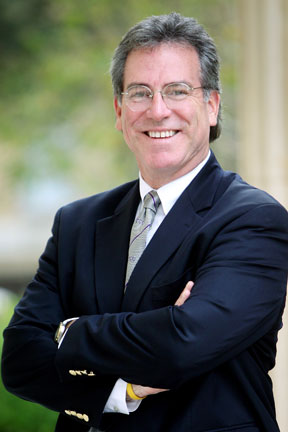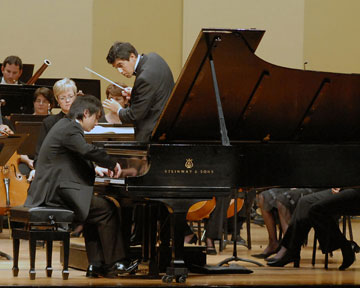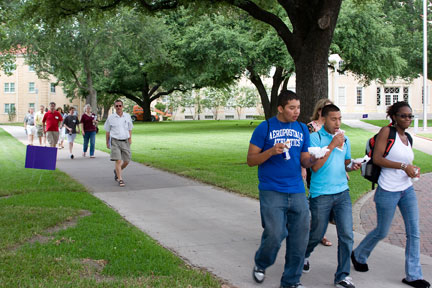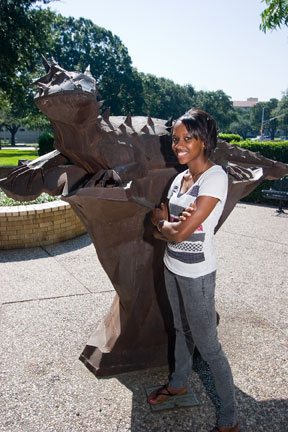Spend enough time at the Ol’ South Pancake House near Texas Christian University and you’ll get the full picture of what students are thinking about these days. Some are worried about finding a job once they graduate, others about where to go: Stay here or leave?
Texas’ economy is doing better than most others states’, and there are still recruiters on campus, at least in some disciplines, looking for people to hire. On the other hand, depending on one’s major, graduating promptly may not be the best idea, or so some instructors have joked to students. Stay around and do graduate work instead of jumping into the job market, they say.
 For plenty of students, the idea of stretching out their college years apparently isn’t a problem: As at most Texas universities, fewer and fewer TCU students are graduating within the traditional four-year span, and they’re piling up growing mounds of college loans as a result.
For plenty of students, the idea of stretching out their college years apparently isn’t a problem: As at most Texas universities, fewer and fewer TCU students are graduating within the traditional four-year span, and they’re piling up growing mounds of college loans as a result.
But for many others – students on scholarships or who are working their way through college – the rising costs of tuition and other needs at Fort Worth’s best-known university are a larger and larger obstacle. Average tuition at TCU (meaning college fees to enroll in courses and not including things like books or room and board) has now reached about $29,000 a year. That’s still moderate compared to the $40,000-plus annual costs at college like Southern Methodist or Rice. But it’s three to five times the rate that Texas students pay at the state’s public colleges.
So why, with far cheaper public universities in the area, would students from Fort Worth or – an even better question – from out of state and other countries continue to pull on the purple of the Horned Frogs? The general answer you get a lot around campus is, for the prestige of a TCU degree.
But what does that mean, and what is the quality of education that students get for their (and their parents’) $29,000 per year? (Full costs of a year at TCU, including things like books and room and board, are closer to $40,000.) Because the truth is that TCU’s ratings on a variety of college rankings and other criteria, while some list it in roughly the top 10 percent of colleges nationwide, still put it generally at the bottom of Texas’ short list of Tier 1 universities (though far above North Texas public colleges like the University of North Texas and the University of Texas at Arlington). And a new (and somewhat controversial) ranking system by Forbes magazine puts TCU near the bottom in a list of 569 colleges from around the country.
In the Forbes list, which gives weight to things like alumni prestige and online student comments as well as more traditional information, TCU ranked lower in faculty ratings, student and faculty awards (that is, scholarships, grants, and fellowships), and graduation rates and worse in student debt than most other well-known public and private universities in the state except Baylor.
Clearly, some programs at TCU continue to be stand-outs: The Neeley Business School is ranked in the top 50 national business schools by The Wall Street Journal and Forbes. The piano studies curriculum draws top-flight students from around the world. And graduates of TCU’s nursing and journalism schools have an enviable track record in finding jobs after graduation.
TCU officials point to their business, music, and pre-med schools’ recognition as proof of the quality of the education they offer. They say TCU remains one of the most “selective” colleges in Texas, based on the percentage of students accepted compared to the numbers who apply. In another important measure, TCU has about a 14-to-1 student-teacher ratio, about the same as SMU’s.
In spite of or because of all those rankings and analyses, TCU in many ways remains Fort Worth’s hometown college – at least for the west side of town. The student body at Texas Christian is more diverse these days than when the campus was populated almost entirely by white Fort Worth residents, and college officials continue to work on attracting students from all economic classes and from all over the world. But many Fort Worth minority students still see the Horned Frogs as a school for rich white kids.
In the end, TCU’s rankings may not matter so much to many of its prospective scholars. The percentage of “legacy” students – whose moms or dads attended TCU – is rising again. And student debt figures may not be a problem if well-off Mom and Dad are paying the t uition bills. Small class sizes and things like the quality of campus life attract many students.
uition bills. Small class sizes and things like the quality of campus life attract many students.
“This is at least the second-best private school in the state,” said Raymond Brown, TCU’s dean of admissions.
TCU didn’t start out with a prestigious reputation or even in a good part of town. The school that would become Texas Christian University was founded by brothers Addison and Randolph Clark in 1869 in the tough part of Cowtown that came to be known as Hell’s Half Acre. When saloons started sprouting up all around, the brothers moved their school to Thorp Spring, about 40 miles southwest of the city.
The Clarks were both ministers but at first were wary of identifying the school as a Christian one, though that changed eventually when they partnered with the Disciples of Christ denomination to further develop the college. The brothers’ most revolutionary step was to create the university as coeducational, a rarity in the post-Civil War era. They’d rather have founded a public university, but because both were former Confederate soldiers, Reconstruction-era federal law prohibited them from holding public office or honors, including teaching at a public institution. The school’s original name was AddRan (for Addison and Randolph) Male and Female Academy.
In the late 1800s, as now, the country was in the midst of an economic recession, and though tuition was modest, most North Texas families still couldn’t afford to send their children to AddRan, said Prof. Gene Smith of the TCU history faculty. “A lot of schools were scraping by, hand-to-mouth,” he said.
The school’s original enrollment of 13 students had grown to more than 100 before the founders started running out of money. When the rent came due and the brothers couldn’t pay, they accepted an offer of financial help from the Disciples of Christ and moved the school to Waco in 1896. Six years later, the school officially partnered with the church organization and changed its name to Texas Christian University.
In 1910, on the morning of March 22, the main building caught fire, from causes that were never determined. Without enough insurance to cover the cost of repairs, the college officials started looking for yet another home. Smith said offers came from Dallas, McKinney, Fort Worth, and Gainesville. After some coaxing from Fort Worth’s Board of Trade and the Fairmount Land Company, which owned much of the real estate in the present-day university area, TCU moved to its present location.
From the early 1900s, the college was known for its Bible school. Through the years, other disciplines wouldn’t always fare as well. For almost a couple of decades in the early 1900s, the campus included a law school. By 1920, however, the American Bar Association had raised its standards, and TCU officials decided to close the law school. The same thing happened to the TCU medical school during that time.
When World War II brought military programs to campus, the school established its own airport, south of what is now I-20, to provide training for Air Force ROTC students. The airport was closed by 1957, Smith said.
After World War II, TCU became more and more secular. First the mandatory daily and weekly chapel meetings were made optional. In the ’70s, the school stopped requiring students to take Christian theology classes, said Bonnie Creel, a TCU graduate who’s now an associate professor of speech at Tarrant County College. Students are still required to take one religion class before they graduate, but they can choose from among courses on a variety of religions. The campus is still generally conservative: The protests and upheaval of the 1960s and ’70s for the most part passed TCU by. Three decades later, the controversy over the war in Iraq seemed barely to register on the campus.
At mid-century, Fort Worth was a far different city than it is today, and that affected families’ decisions about sending their kids to TCU. Fort Worth was still a wide-open town, with widespread gambling, the Jacksboro Highway lineup of bars in full swing, and elements of organized crime in operation. Ray Brown, TCU’s dean of admissions, grew up in Mineral Wells and remembers Cowtown’s rough-and-tumble reputation. People from Mineral Wells shied away from the city then, he said, because they feared getting beaten up.
Those factors probably helped keep tuition rates modest for a long time. TCU charged $25 per semester hour in the late 1960s, for example. But in the following decade, when national college costs started rising, TCU followed suit, Creel said, and doubled its tuition rate.
In the ’90s, there was a move to rebrand the institution as TCU, rather than marketing it by its full name, which college officials feared could drive non-Christian students away. These days, the Disciples of Christ, the school’s religious authority, is mostly hands-off unless students decide to study divinity at the Brite School. And more students list themselves as Catholics, Methodists, and Baptists than as Christian Church members.
Fort Worth and the city have prospered and developed in about equal measure in the last few decades, and tuition rates have kept zooming. Now, however, tuition increases are outpacing inflation, and some wonder whether families will be able to keep up.
“There hasn’t been a year where tuition hasn’t gone up since I’ve been working for universities,” Brown said, “and I expect it to go up again.”
Ranking the performance of colleges is more art than science, given that a university’s academic quality is likely to be uneven across different disciplines and also because so many other factors are involved. Is it a friendly campus, in a safe part of town? Are classes small? Is it a party palace? Does it have decent undergraduate resources but little true research or other groundbreaking graduate work going on?
For a couple of decades, U.S. News & World Report has released college ratings that are some of the best known in the country. In the most recent list, TCU was ranked 113th out of 1,476 colleges, a drop from last year and each year since 2006 when it was number 96.
The reason for the drop in scores? Peer evaluations from other universities’ top administrators. That still puts TCU among the best-rated universities in the state, but below other Texas Tier 1 universities (that is, major research institutions with large endowments) – Rice, UT-Austin, Texas A&M, SMU, and Baylor. The U.S. News ranking showed TCU to be neither the most exclusive (based on percentage of applicants accepted) Tier 1 university in the state, nor the smallest. (Top-ranked Rice has about 5,200 students compared to TCU’s 8,600; UT-Austin, on the other hand, has more than 50,000 students.)
 But in the Forbes study, devised by the Center for College Affordability and Productivity, a Washington D.C.-based think tank, TCU fared far worse. The college placed 513th out of 569 universities in the survey released last August. The Forbes rankings differ from those done by U.S. News by taking into account teacher evaluations, the prominence of alumni, and the level of student debt at graduation.
But in the Forbes study, devised by the Center for College Affordability and Productivity, a Washington D.C.-based think tank, TCU fared far worse. The college placed 513th out of 569 universities in the survey released last August. The Forbes rankings differ from those done by U.S. News by taking into account teacher evaluations, the prominence of alumni, and the level of student debt at graduation.
Critics point out that the teacher evaluations, taken from online reviews of professors from ratemyprofessors.com, an anonymous service run by MTV, are highly unscientific. They also note that Forbes‘ measure of alumni prominence is based on alumni in Who’s Who in America – which is published by Forbes. On the other hand, the U.S. News ratings have also been attacked by some researchers and academics as being subject to manipulation by college administrators.
The Who’s Who criterion was the only one on which TCU scored well in the Forbes study, ranking 158th on the list. Prominent alumni such as CBS’ Bob Schieffer and the San Diego Chargers’ LaDainian Tomlinson boosted TCU’s score on that measure.
One of the factors that brought TCU so low in the Forbes study was student debt. The average TCU student graduates with about $27,000 in debt, said Matthew Denhart, a research assistant with the center that designed the study. The national average for debt after college is about $21,000; in Texas private colleges the average is about $19,000. TCU also lagged behind other Texas public and private universities in professor ratings and graduation rates, bested not only by other Tier 1 schools but also by state schools such as the University of North Texas and Sam Houston State University.
More scholarships and grants for students, of course, could cut down on those debts, but TCU is behind there too. The university placed 493th in student grants and scholarships and 499th in faculty awards, according to the study. Only about 12 percent of TCU students receive Pell Grants because most aren’t poor enough to qualify. Compare that to the 20 to 40 percent of students using Pell Grants at colleges like UT-Austin, Baylor, and Sam Houston State. (Only Rice has fewer Pell recipients than TCU.) The U.S. Department of Education-sponsored grants are calculated on the cost of attending school minus a student’s “expected family contribution.”
The relative lack of student and faculty awards, like the declining graduation rates, went largely unnoticed until recently at TCU, said Brown, the dean of admissions. Things started to change with the arrival in 2003 of Chancellor Victor J. Boschini Jr. (TCU does not have a president). Brown said that since then, TCU officials have paid more attention to students who may be at risk of dropping out, switching universities, or taking too long to graduate.
TCU’s graduation rate – about 55 percent of their students graduate within four years – is about average for the nation. But rates have been sagging at almost every Texas college.
 Boschini, whom Brown said has a background in student affairs, has pushed for more interventions to keep students in school and moving toward their degrees. “Instead of just giving students transfers, staff, advisers, and faculty ask why,” he said.
Boschini, whom Brown said has a background in student affairs, has pushed for more interventions to keep students in school and moving toward their degrees. “Instead of just giving students transfers, staff, advisers, and faculty ask why,” he said.
College staffers even go out knocking on student doors in October to see how they are doing at TCU and how they’re feeling about the school. (Freshmen and sophomores are still required to live on campus, a once-common requirement that has been dropped by most other universities.)
As for urging kids to apply themselves enough to graduate in the usual time, “That was never really much a priority with us,” Brown said. “But there is no reason why kids shouldn’t graduate in four years.”
Creel, the TCC speech professor and TCU grad, said the families and students at her alma mater are willing to pay private-college tuition because they want both smaller classes than they would find in a state university and the cachet that a TCU degrees carries. “Students value the small class size, rigor, and prestige,” she said.
At TCU, programs such as the Neeley School of Business have been garnering prestige for the college by landing full-time jobs for almost 70 percent of graduating seniors. Forbes gave the business school high marks based on the pay that its grads are raking in five years after getting their degrees (minus the cost of tuition and the forgone salary while in school). Neeley was ranked 52nd out of 102 business schools examined.
The university is also known for its music program. Although it is much smaller than that at UNT in Denton, the program draws world-class students, especially to its piano program. The school frequently picks up accolades from the National Federation of Music Clubs.
TCU boasts quality programs in business, liberal arts, fine arts, and nursing, among others. The Schieffer School of Journalism was the first at a Texas private university to be approved by the Accrediting Council for Education in Journalism and Mass Communications. Only about a fifth of university journalism programs in the country obtain accreditation.
TCU’s teacher education program also puts up some impressive numbers, including a six-year record of finding jobs for every one of its graduates within a month of earning their degrees.
John Thompson, the university’s executive director of career services, said the Dallas-Fort Worth area continues to do relatively well in hiring graduating students, thanks to the health of the Texas economy compared to that of most other states. Although the amount of full-time offers being extended to TCU students is down, he said, the number of interns being placed has increased about 40 percent from this time last year.
“It’s not as good as it was two years ago, but then again things aren’t as bleak here” as elsewhere, Thompson said.
For most of its existence, TCU drew the majority of its students from Fort Worth. But beginning in the 1980s, the emergence of other area universities diverted many local students from the Fort Worth school, said Smith, the TCU history professor. These days, according to university data, about 33 percent of Horned Frog students come from the Metroplex.
Smith said that in the ’70s and ’80s, when tuition prices started going up nationally, the legacy aspect of enrollment at TCU began to slowly diminish, as fewer students chose to attend their parents’ alma mater.
But now, said Brown, the ranks of legacy students are growing again. “If we admitted by legacy only, we could more than fill the freshman class,” the dean of students said.
That kind of tradition – and the exclusivity that TCU prides itself on – has its downside for many local residents. Carrie Grant, the academic coordinator at Diamond Hill-Jarvis High School, said students at her school, which is about 96 percent Hispanic, often  view TCU as a “white school.”
view TCU as a “white school.”
Many a TCU-area bartender and club patron has been put off by the attitudes of “trust-fund babies” from the school. One TCU student wrote to Fort Worth Weekly a few years ago that such attitudes were understandable because, a few years down the road, TCU students would likely own the businesses that would hire the people who were complaining.
On the studentsreview.com web site (where TCU got an overall B rating, with an A- in education quality), students leave comments about how they perceive their campuses. TCU student posters mostly described their campus as friendly – but a significant minority said “snooty” was more like it and repeated the stereotypes about rich kids.
“It’s kind of like a city within a city,” Grant said. The perception remains despite the fact that TCU officials have repeatedly visited Diamond Hill and other area high schools to encourage students to apply. They also promote the Community Scholars Program, which pays about 60 percent of tuition costs for minority students based on good grades.
The TCU student body now is about three-quarters white, making it more racially diverse than it’s ever been (and about as diverse as many other Texas private colleges). The school’s recruiters are working to attract more minority, foreign, and out-of-state students.
Tamara Sherrod, a junior from Houston, takes part in that effort. The president of TCU’s Black Students Association, she goes to heavily minority high schools to tell students that TCU isn’t a bastion of whiteness that’s closed to them. She fights that assumption at home, too: The first thing some of her friends and neighbors back home say when she tells them she’s going to TCU is that it’s a “white school.”
She doesn’t disagree that white students predominate. “If there are three minority students in my class, it’s a surprise,” Sherrod said. The school, she said, “has good points and bad.”
The good? Minority students on campus tend to be a more tightly knit group than they might be at a large public school, which helps deal with what Sherrod calls the culture shock that many minority students feel at TCU, especially if they didn’t go to white-dominated high schools. She said instances of racism happen at TCU as at any other campus, but that it’s not blatant.
It’s not the specter of racism, but the size of the tuition bill that keeps many minority students and their families away, she said. “If I had known about the tuition [increases] before I came here, I would have gone somewhere else,” she said. “I came in when it [total annual expense] was under $30,000. Now it’s pushing $40,000.”
Regardless, she still believes it’s worth it. “We complain that, ‘Oh, it’s so expensive,’ ” she said. “But I know my degree will speak for itself.”











